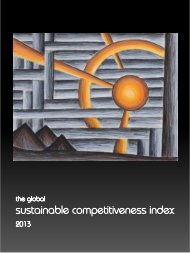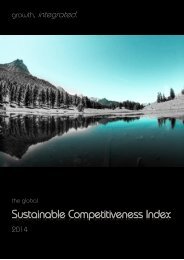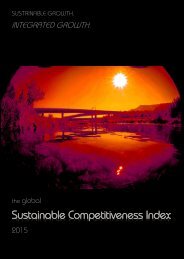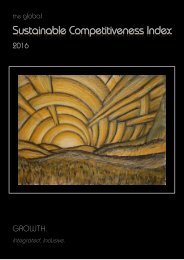Global Competetiveness Report
You also want an ePaper? Increase the reach of your titles
YUMPU automatically turns print PDFs into web optimized ePapers that Google loves.
Country Rankings<br />
Resource Intensity<br />
Resource intensity and efficiency are not<br />
God-given. They depend on technology,<br />
policies, and applied incentives . A decade<br />
of intelligent polices can make immense<br />
differences to the national efficiency and<br />
intensity of a country. Tools available to<br />
nations include, amongst others:<br />
• Taxes: higher resource taxes increase<br />
incentives to increase efficiency. Countries<br />
that have introduced resource taxes in the<br />
past have higher resource efficiency than<br />
similar economies with lower taxes (e.g.<br />
Japan). Economic actors in countries<br />
where resources (in particular energy)<br />
have been or are subsidised have even<br />
less incentives to increase efficiency. In<br />
addition, countries with higher taxes have<br />
more room for leveraging fluctuations and<br />
spikes in the global energy markets<br />
through temporary easing of taxes.<br />
However, it might be argued that this<br />
measurement is currently not opportune<br />
considering the expected rise of costs of<br />
resources in the near- to mid-term future<br />
• Infrastructure investment: upgrading<br />
existing or building new efficient<br />
infrastructure (transport, power, buildings)<br />
increases efficiency, while lowering longterm<br />
cost and reduces dependency on<br />
resource imports. In addition, this<br />
measurements can have positive impacts<br />
on the job market and unemployment<br />
figures<br />
• Targeted R&D support and other<br />
measurements for key growth industries<br />
• Mandatory efficiency standards (cars,<br />
electronic appliances, buildings, etc.)<br />
• Mandatory efficiency labels, public<br />
awareness campaigns<br />
Resource Intensity<br />
Country Rank Score<br />
Turkmenistan 133 39.7<br />
Namibia 134 39.4<br />
Botswana 135 39.3<br />
Lebanon 136 39.1<br />
Ireland 137 39.0<br />
Bolivia 138 38.8<br />
Kosovo 139 38.8<br />
Mexico 140 38.6<br />
Macedonia 141 38.4<br />
Finland 142 38.2<br />
Cyprus 143 37.9<br />
Seychelles 144 37.8<br />
West Bank and Gaza 145 37.0<br />
Russia 146 36.9<br />
Norway 147 36.2<br />
China 148 36.1<br />
Yemen 149 35.2<br />
Hong Kong 150 35.1<br />
Jordan 151 34.8<br />
Algeria 152 34.6<br />
Qatar 153 34.4<br />
Macao 154 34.0<br />
Malaysia 155 33.4<br />
Australia 156 32.9<br />
Libya 157 32.7<br />
South Korea 158 31.8<br />
Benin 159 31.0<br />
Mongolia 160 30.9<br />
Bahamas 161 30.3<br />
Bosnia and Herzegovina 162 29.7<br />
Vietnam 163 29.7<br />
Estonia 164 29.5<br />
Kuwait 165 28.9<br />
Greenland 166 27.6<br />
Bahrain 167 27.5<br />
Iran 168 27.2<br />
South Africa 169 25.5<br />
Kazakhstan 170 24.9<br />
Brunei 171 24.4<br />
Fiji 172 24.2<br />
Trinidad and Tobago 173 21.8<br />
United Arab Emirates 174 20.4<br />
Saudi Arabia 175 17.6<br />
Oman 176 14.6<br />
The <strong>Global</strong> Sustainable Competitiveness Index<br />
45








